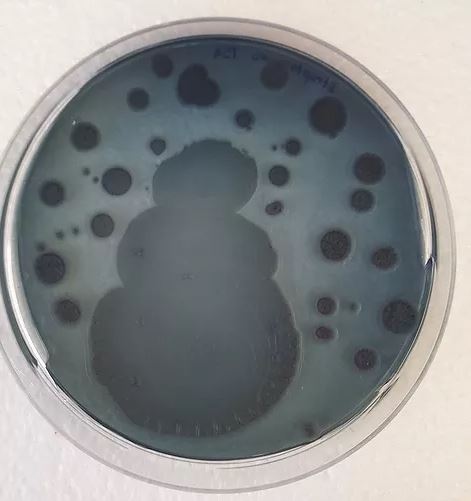By Christina Julius
When we think about bacteria, we tend to think of spoiled food and illness. But not all bacteria are bad- they are the most diverse organisms on the planet! They are important for a range of biochemical processes, such as helping cattle to digest grass and producing cheese from milk. To study bacteria, we can grow bacteria into colonies on plates containing a media (agar) of essential nutrients and chemicals. We can also use bacteria to make some fascinating and festive images to wish you all a Merry Christmas.




For making these images I had a lot of help finding strains and media. I want to thank all my colleagues at CBCB (Newcastle University)- especially Yulia Yuzenkova, Amber Riaz-Bradley, Charles Winterhalter, Kaveh Emami, Fernando Santos Beneit, Valeria Verrone and Olga Chrobak.
The bacteria behind the photos
1. Christmas Tree: Synechocystis sp. PCC 6803. Cyanobacteria are usually green due to photosynthesis but here it seems that the presence of a lot of glucose (food) lead the strain to turn slightly yellow.
Christmas Baubles: Streptomyces spp. Streptomyces are actinobacteria and the natural source of many antibiotics e.g. streptomycin, tetracycline or chloramphenicol.
2. Merry Christmas: E. coli MG1655. E. coli is the most commonly used model organism in microbiology.
Stars: E. coli MG25113. This strain is genetically altered and contains GFP (green fluorescent protein). The addition of arabinose induces the expression of GFP.
3. Snowman: Streptomyces coelicolor M145. This Streptomyces produces the antibiotic actinorhodin which diffuses into the agar and dyes it blue. At prolonged incubation, the cells will start to produce spores as a survival mechanism, which would turn the snowman white.
4. Small Christmas Tree: Klebsiella pneumoniae. An opportunistic pathogen that causes urinary or respiratory tract infections and is often transmitted via hospital equipment or staff. Many strains also have a multitude of antibiotic resistances. The patients from which the strains were isolated suffered from reoccurring bacteremia (blood infection).
Christmas baubles: E. coli.The strain here is not a model organism from the lab but a blood isolate from the hospital. Some pathogenic strains of the otherwise harmless species E.coli can cause very severe conditions. Often they are multi-resistant.